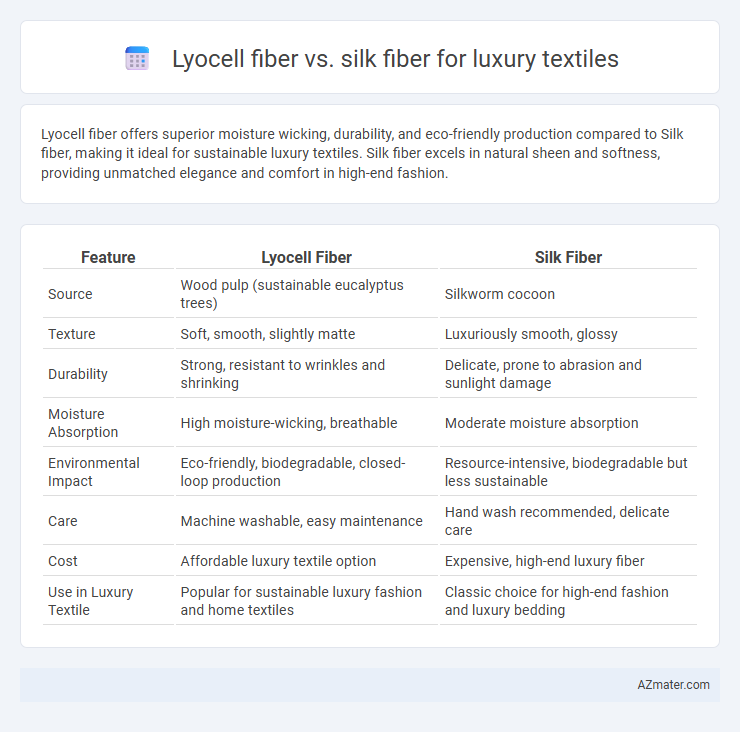Lyocell fiber offers superior moisture wicking, durability, and eco-friendly production compared to Silk fiber, making it ideal for sustainable luxury textiles. Silk fiber excels in natural sheen and softness, providing unmatched elegance and comfort in high-end fashion.
Table of Comparison
| Feature | Lyocell Fiber | Silk Fiber |
|---|---|---|
| Source | Wood pulp (sustainable eucalyptus trees) | Silkworm cocoon |
| Texture | Soft, smooth, slightly matte | Luxuriously smooth, glossy |
| Durability | Strong, resistant to wrinkles and shrinking | Delicate, prone to abrasion and sunlight damage |
| Moisture Absorption | High moisture-wicking, breathable | Moderate moisture absorption |
| Environmental Impact | Eco-friendly, biodegradable, closed-loop production | Resource-intensive, biodegradable but less sustainable |
| Care | Machine washable, easy maintenance | Hand wash recommended, delicate care |
| Cost | Affordable luxury textile option | Expensive, high-end luxury fiber |
| Use in Luxury Textile | Popular for sustainable luxury fashion and home textiles | Classic choice for high-end fashion and luxury bedding |
Introduction to Lyocell and Silk Fibers
Lyocell fiber, derived from sustainably sourced wood pulp and produced through an eco-friendly closed-loop process, offers a soft, breathable, and highly absorbent alternative to traditional fibers in luxury textiles. Silk fiber, obtained from silkworm cocoons, is prized for its natural sheen, smooth texture, and exceptional strength, making it a timeless choice for high-end fabrics. Both fibers provide luxurious comfort, but Lyocell emphasizes sustainability and moisture management, while silk focuses on elegance and tensile resilience.
Origins and Production Processes
Lyocell fiber, derived from sustainably sourced eucalyptus wood pulp through a closed-loop solvent spinning process, offers an eco-friendly alternative to traditional textiles, producing minimal waste and low environmental impact. In contrast, silk fiber originates from the natural secretion of silkworms, harvested through labor-intensive sericulture that involves boiling cocoons to extract long, continuous filaments. While Lyocell emphasizes renewable raw materials and modern industrial techniques, silk relies on ancient biological processes and artisanal craftsmanship integral to luxury textile heritage.
Environmental Impact and Sustainability
Lyocell fiber, produced from sustainably sourced eucalyptus pulp through a closed-loop process, offers a significantly lower environmental footprint compared to conventional silk, which relies on energy-intensive sericulture and mulberry cultivation. Lyocell's biodegradable nature and minimal water usage align with luxury textile brands' increasing demand for eco-friendly materials, while silk production involves pesticide use and higher greenhouse gas emissions. Prioritizing Lyocell over silk supports sustainable fashion initiatives by reducing resource depletion and chemical pollution without compromising the premium feel desired in luxury fabrics.
Texture, Softness, and Visual Appeal
Lyocell fiber offers a smooth, silky texture with exceptional softness, making it a popular eco-friendly alternative in luxury textiles. Silk fiber is renowned for its natural sheen and fine, smooth feel that exudes opulence and elegance. Visually, silk displays a lustrous, glossy surface, while Lyocell provides a subtle matte finish that enhances modern, understated luxury aesthetics.
Breathability and Moisture Management
Lyocell fiber offers superior breathability and moisture management compared to silk fiber, making it highly suitable for luxury textiles in warm climates. Its cellulose-based structure allows it to wick moisture efficiently, promoting faster evaporation and keeping the skin dry. Silk fibers, while breathable, tend to retain moisture longer, which can lead to discomfort in humid conditions and less effective moisture regulation.
Durability and Longevity
Lyocell fiber offers superior durability and resistance to wear compared to silk fiber, making it more suitable for long-lasting luxury textiles. Lyocell's tensile strength and moisture-wicking properties enhance fabric resilience and prevent degradation over time. Silk, while luxurious and soft, is more delicate and prone to abrasion and environmental damage, limiting its longevity in high-use applications.
Hypoallergenic and Skin-Friendliness
Lyocell fiber, derived from sustainable wood pulp, offers superior hypoallergenic properties compared to silk fiber, making it ideal for sensitive skin and luxury textiles. Its smooth surface minimizes irritation and moisture retention, promoting breathability and comfort throughout wear. Silk fiber, while naturally smooth and breathable, may cause allergic reactions in some individuals due to protein residues, reducing its suitability for skin-sensitive users.
Dyeability and Color Vibrancy
Lyocell fiber exhibits superior dyeability compared to silk fiber, absorbing dyes deeply and producing consistently vibrant colors ideal for luxury textiles. Silk fibers, while naturally lustrous and capable of rich color expression, can experience uneven dye uptake and fading over time due to their protein structure. Lyocell's cellulose-based composition allows for a broader spectrum of dye compatibility, enhancing long-lasting color vibrancy and making it a preferred choice for high-end garment applications.
Price Comparison and Market Availability
Lyocell fiber offers a cost-effective alternative to silk fiber in luxury textiles, with prices generally ranging from $10 to $20 per kilogram compared to silk's $30 to $50 per kilogram, reflecting differences in production complexity. Lyocell, made from sustainably sourced wood pulp, benefits from higher market availability due to scalable manufacturing processes and growing consumer demand for eco-friendly materials. Silk, prized for its natural luster and softness, remains less available and more expensive due to labor-intensive sericulture and limited geographic production regions.
Choosing the Best Fiber for Luxury Textiles
Lyocell fiber offers exceptional moisture-wicking and breathability, making it ideal for luxury textiles focused on comfort and sustainability. Silk fiber excels in natural luster, softness, and thermal regulation, providing a timeless elegance and luxury feel. Choosing the best fiber depends on prioritizing eco-friendliness and durability with Lyocell or opting for traditional luxury and sheen with silk.

Infographic: Lyocell fiber vs Silk fiber for Luxury textile
 azmater.com
azmater.com